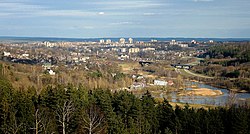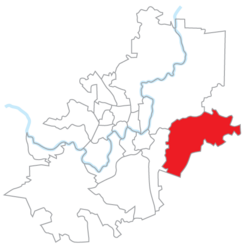
Vilnius is the capital of and largest city in Lithuania, and the second-most populous city in the Baltic states. As of January 2024, Vilnius' estimated population was 602,430, and the Vilnius urban area which extends beyond the city limits has an estimated population of 708,627.

The Republic of Central Lithuania, commonly known as the Central Lithuania, and the Middle Lithuania, was an unrecognized short-lived puppet state of Poland, that existed from 1920 to 1922. It was founded on 12 October 1920, after successful Żeligowski's Mutiny, during which the volunteer 1st Lithuanian–Belarusian Division under command of general Lucjan Żeligowski seized the Vilnius Region that Lithuania made claims to. It was incorporated into Poland on 18 April 1922.
The city of Vilnius, the capital and largest city of Lithuania, has an extensive history starting from the Stone Age. Vilnius was the head of the Grand Duchy of Lithuania until 1795, even during the Polish–Lithuanian Commonwealth. The city has changed hands many times between Imperial and Soviet Russia, Napoleonic France, Imperial and Nazi Germany, Interwar Poland, and Lithuania. It was especially often the site of conflict after the end of World War I and during World War II. It officially became the capital of independent, modern-day Lithuania when the Soviet Union recognized the country's independence in August 1991.

Vilnius Region[a] is the territory in present-day Lithuania and Belarus that was originally inhabited by ethnic Baltic tribes and was a part of Lithuania proper, but came under East Slavic and Polish cultural influences over time.

Vilnius District Municipality is one of the 60 municipalities in Lithuania. It surrounds the capital city of Vilnius on three sides. The municipality is also bordered by Trakai district and Elektrėnai municipality in the west, Astravyets and Ashmyany districts of Belarus in the east, Širvintos, Molėtai and Švenčionys districts in the north and Šalčininkai district in the south.

Venta is a small city in Lithuania in the Akmenė district municipality. According to a 2021 census, there are 2,250 people living in Venta. It is situated along the Venta River, Kuršėnai-Mažeikiai highway, and a railroad connecting Mažeikiai with Šiauliai. This makes Venta better situated than Naujoji Akmenė, the capital of the district. Venta is also one kilometre (0.62 mi) from the small villages of Žerkščiai and Pašilė (Akmenė). There is a small bridge connecting Venta to Žerkščiai. There are 2 Seniūnaitijas which make up Venta; "Draugystės" and "Ventos Miesto".
Ypatingasis būrys or Special Squad of the German Security Police and SD was a killing squad operating in the Vilnius Region in 1941–1944. The unit, primarily composed of Lithuanian volunteers, was formed by the German occupation government and was subordinate to Einsatzkommando 9 and later to Sicherheitsdienst (SD) and Sicherheitspolizei (Sipo).p.15 The unit was subordinated to German police, and had no official autonomy. In Polish they were colloquially called strzelcy ponarscy.

Rokantiškės Castle ruins are in Naujoji Vilnia elderate of Vilnius, Lithuania.
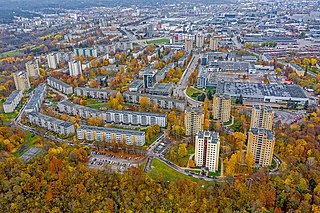
Žirmūnai is the most populous administrative division (elderate) in Vilnius. It is also a neighbourhood in the Lithuanian capital city Vilnius, encompassing the city district of the same name, built in the 1960s.
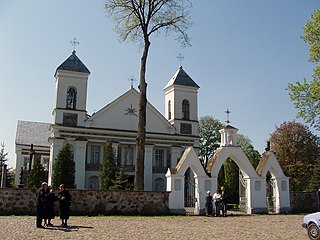
Valkininkai is a historic town in Valkininkų (Valkininkai) eldership, Varėna District Municipality, Alytus County, Lithuania, located about 22 km (14 mi) northeast from Varėna and about 55 km (34 mi) southwest from Vilnius. At the Lithuanian census of 2001, its population was 238 and at the census of 2011 it was 229.

The Soviet–Lithuanian Mutual Assistance Treaty was a bilateral treaty signed between the Soviet Union and Lithuania on October 10, 1939. According to provisions outlined in the treaty, Lithuania would acquire about one fifth of the Vilnius Region, including Lithuania's historical capital, Vilnius, and in exchange would allow five Soviet military bases with 20,000 troops to be established across Lithuania. In essence the treaty with Lithuania was very similar to the treaties that the Soviet Union signed with Estonia on September 28, and with Latvia on October 5. According to official Soviet sources, the Soviet military was strengthening the defenses of a weak nation against possible attacks by Nazi Germany. The treaty provided that Lithuania's sovereignty would not be affected. However, in reality the treaty opened the door for the first Soviet occupation of Lithuania and was described by The New York Times as "virtual sacrifice of independence."
The following is a timeline of the history of the city of Vilnius, Lithuania.
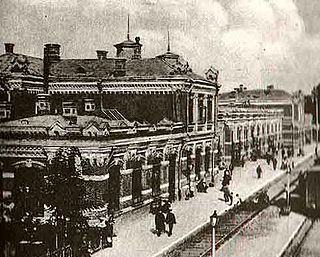
Libau–Romny Railway was a railway company that built a railway line in the Russian Empire in 1871–74 to connect Romny in Ukraine with the port in Libau (Liepāja) in present-day Latvia. To do so it passed through Minsk The objective of the railway was to deliver Ukrainian exports, particularly grain, to the Baltic Sea where it could be further shipped.

Naujoji Vilnia railway station is a Lithuanian Railways station in Vilnius. The station was built around 1860.

Antoni Olechnowicz was a Polish military officer. A Lieutenant Colonel of the Polish Army, he took part in the September Campaign. Arrested by the Soviets, he escaped and returned to his native Vilnius, where he soon joined the Polish underground: the Service for Poland's Victory, the Union of Armed Struggle and finally the Home Army. He took part in the Operation Ostra Brama as commanding officer of the East group attacking the city of Vilnius from the direction of Naujoji Vilnia and Belmontas.

Anton Ivanavič Luckievič was a leading figure of the Belarusian independence movement in the early 20th century, an initiator of the proclamation of the independence of Belarus, the Prime Minister and the Minister of Foreign Affairs of the Belarusian Democratic Republic persecuted by the Soviet authorities. He was a brother of Ivan Luckievič.

Galgiai is a village in Vilnius District Municipality, Lithuania. According to the 2011 census, it had population of 1,426, an increase from 1,011 in 2001, 811 in 1989 and just 96 in 1959.
The Communist Party of Lithuania was a short-lived political party in the Soviet Lithuania/Socialist Soviet Republic of Lithuania and Belorussia.

The Battles for Vilnius in 1918–1919 were a series of battles fought in Vilnius between the pro-Polish Self-Defence of Lithuania and Belarus who were initially against the Imperial German Army retreating from the city and the Bolshevik paramilitaries and then against the attacking Red Army. The fighting resulted in the temporary capture of most of the city of Vilnius by the Poles, who eventually had to retreat before the Red Army came. Some historians consider this as the beginning of the Polish–Soviet war.
